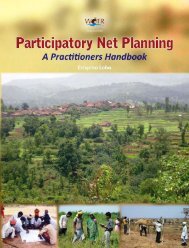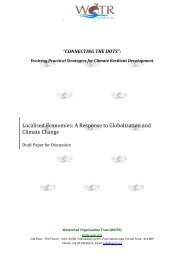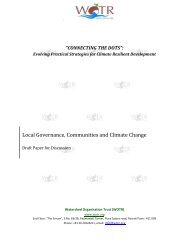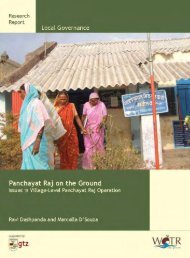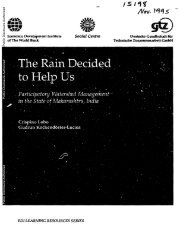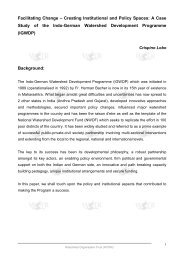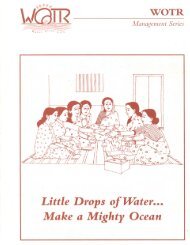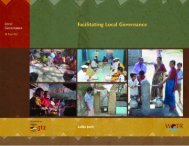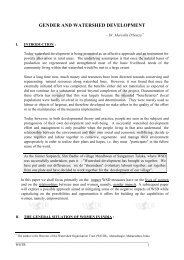The Hot Water Chullah: Findings From An ... - EcoLogic - wotr
The Hot Water Chullah: Findings From An ... - EcoLogic - wotr
The Hot Water Chullah: Findings From An ... - EcoLogic - wotr
You also want an ePaper? Increase the reach of your titles
YUMPU automatically turns print PDFs into web optimized ePapers that Google loves.
1] Background and motivation<br />
<strong>The</strong> <strong>Hot</strong> <strong>Water</strong> <strong>Chullah</strong>: <strong>Findings</strong> <strong>From</strong> <strong>An</strong> Assessment<br />
- Arjuna Srinidhi<br />
Progress and development on one hand and the need to conserve the environment and reduce<br />
carbon emissions on the other are two concerns that need to be addressed simultaneously when<br />
cooking fuel needs of rural communities is under consideration. In rural Maharashtra, an estimated<br />
80-85% of the households are still dependent on firewood and agro-waste for cooking 1 . Collecting<br />
firewood takes up an increasing amount of time and effort, worsening the drudgery of the women<br />
for essential, but less productive chores. <strong>An</strong>d as is well known, the smoke generated from these<br />
chullahs causes considerable indoor air-pollution leading to serious health issues, as well as<br />
increases the carbon release into the atmosphere.<br />
Today various innovations for both stoves as well as cooking fuel are emerging to respond to this<br />
daily need. Villagers and development agencies (NGOs, CSOs etc) are flooded with choices. WOTR<br />
too is constantly in search of good options.<br />
Since the early 2000s WOTR has been promoting an energy efficient, smokeless <strong>Hot</strong> <strong>Water</strong> <strong>Chullah</strong>.<br />
This chullah incorporates a design that results in proper oxidation leading to higher fuel efficiency. In<br />
addition, it utilizes the energy lost through radiation and convection for heating water. As it also has<br />
a smoke outlet that is carried out of the house thus reducing indoor-air pollution. <strong>The</strong> <strong>Hot</strong> <strong>Water</strong><br />
<strong>Chullah</strong> (HWC) was promoted as a part of the project “Building Capacities for Climate Change<br />
Adaptation in Rural Communities” with the support of a German organisation called<br />
Evangelischer Entwicklungsdienst or EED in short. A few hundreds of chullahs were installed<br />
in the Jalna district.<br />
2] Objectives of the study:<br />
In keeping with WOTR’s philosophy of continuously improving current designs and practices, as also<br />
being aware that the mere installation of such products is not necessarily successful, WOTR<br />
undertook a quick survey of the installations to assess the current acceptance by new users, and to<br />
identify modifications where required. <strong>The</strong> objectives of the study were to determine:<br />
(i) the level of adoption of the HWC<br />
(ii) the benefits in terms of time saved, amount of fuel-wood and agro-wastes used and<br />
health benefits.<br />
(iii) the modifications in design (if required) to improve use and practicality.<br />
3] Methodology
A questionnaire to address the above objectives was initially designed in English. Once the content<br />
was approved by the research team, it was translated to Marathi and re-checked for consistency<br />
with the field team and then field tested, following which appropriate modifications were made.<br />
It was decided that the survey would be carried out by the Panlot sevaks and Wasundhara sevaks,<br />
but not in the same villages where they work to ensure they are unbiased in the data collection. A<br />
two-day training was conducted that included class room training, field demonstration and handholding<br />
exercises for the survey and data collection work.<br />
Selection of households for the survey: <strong>From</strong> the total households (of Poor and Very Poor wealth<br />
ranking category) where these HWCs had been installed, about one hundred households were<br />
selected at random from eight villages (four each from Bhokardan and Jaffrabad blocks).<br />
4] Observations and results of survey<br />
(i) <strong>The</strong> table below gives the details of households using the chullah, those of the ‘Very Poor’<br />
category surveyed, where the HWCs were installed, and the percentage of households where the<br />
HWC has completely replaced the traditional chullah.<br />
Table 1:<br />
No. Percentage<br />
Households surveyed (total) 104 100<br />
Very poor category (Wealth Rank) 93 89.4<br />
Poor category (Wealth Rank)<br />
Traditional chullah was totally replaced<br />
11 10.6<br />
or used minimally<br />
Traditional chullah is used in addition<br />
41 39.4<br />
to <strong>Hot</strong> <strong>Water</strong> <strong>Chullah</strong> 63 60.6<br />
In 39% (41) of the households, the HWC had completely replaced the traditional chullah and was<br />
being used for all cooking needs, while in the remaining 63 houses where the traditional chullah had<br />
not been completely replaced. <strong>The</strong> HWC was, in these cases as well, the primary stove, but the<br />
traditional chullahs served as a useful additional stove to supplement their cooking needs.<br />
One possible reason for these HWCs not replacing the traditional stoves completely is that the family<br />
size in these cases was found to be larger (avg family size of 5) than in cases where they had<br />
completely replaced the traditional stove (avg family size of 4). <strong>The</strong> additional cooking demands<br />
possibly compelled these families to use both stoves.<br />
<strong>An</strong>other observation in houses where more than one chullah was being used is that the HWC was<br />
not used for making tea. Traditional chullahs were still being used for such small cooking. This was<br />
apparently due to the wide opening at the top of the HWC leading to heat losses.<br />
One extremely encouraging factor observed throughout the survey was that there were no instances<br />
of the HWC lying abandoned or totally unused. Although there were cases where we found the
stoves had been kept outside the house due to space constraints, the chullahs were still being with<br />
the exception of rainy days. This was the case especially for the smaller houses in the centre of the<br />
villages that are closely surrounded with other houses and shared common walls. Some of such<br />
households found the design and orientation of the chullah to be a hindrance. A suggestion that<br />
came from these households was to provide them with the option of having the outlet pipe on the<br />
opposite side of the cooker as an option.<br />
(ii) <strong>The</strong> savings in fire-wood and time for cooking can be seen in the table below:<br />
Table 2 :<br />
Average per household (for all<br />
104 HHs)<br />
Pre-<br />
HWC Post-HWC<br />
Firewood (kgs/week) 48.8 27.5<br />
Time for cooking (hours/day) 3.6 2.0<br />
<strong>The</strong> amount of firewood used per week was estimated based on the number of headloads that<br />
people collected each week. 1 head load was found to be approximately 10 kgs. <strong>The</strong> range for<br />
weight of firewood used a week varied from about 10 kg to 90 kg, while the time for cooking varied<br />
from 1 hour to 6 hours.<br />
As can be seen from the above figures, the amount of firewood being used has reduced by over 40%.<br />
This leads to savings of about 1000 kgs of wood a year per HH or over 1,600 kg of CO2 equivalents.<br />
(iii) <strong>The</strong> source for most of the fuel was agriculture waste. About 40 households needed wood from<br />
trees – sourced from their backyard, gathering leaves and twigs, cutting wood from trees and in<br />
some cases purchasing wood from the market. Especially during festivals, marriages and other<br />
public gatherings, it was essential to supplement fuel-wood gathered (from their homes) with<br />
purchased wood. <strong>The</strong> amount of wood purchased for such special events was in the order of 200 to<br />
400 kilos per year from the local market at a cost of Rs 4 to Rs 5 per kilo.<br />
(iv) <strong>The</strong> women folk from every household were asked to rank on a scale of 1 to 5 the<br />
amount of smoke, irritation to eyes and accidents during operation they experienced. By<br />
accidents we were referring to potential dangers during operation such as burns, fires,<br />
etc. <strong>The</strong> rankings were done with reference to two periods – A) pre-HWC installation,<br />
and B) post-HWC installation. <strong>The</strong> following graph shows the average rank given from<br />
the survey. (Lower the rank, better is the result).<br />
Figure 1:
Relative Rank<br />
Overall, the most appreciated fact about the hot water chullah was the lesser work (drudgery) for<br />
women that it involved – in terms of reduced cooking time and lesser fuel to be gathered. Together<br />
with the positive health benefits from lesser exposure to smoke, we believe that these results can<br />
certainly be used to successfully promote the <strong>Hot</strong> <strong>Water</strong> <strong>Chullah</strong>.<br />
5] Conclusions<br />
Amongst the households that were using the <strong>Hot</strong> <strong>Water</strong> <strong>Chullah</strong>s, it was unanimously accepted to be<br />
the most favoured chullah. <strong>The</strong> relatively better-off sections might have access to cleaner fuels such<br />
as LPG, but for the Very Poor and Poor groups in a village, the <strong>Hot</strong> <strong>Water</strong> <strong>Chullah</strong> was found to be<br />
extremely beneficial in terms of the fuel saved, time saved, lesser drudgery and lesser exposure to<br />
indoor air-pollution.<br />
A number of useful design modifications were suggested by the users that are being tested by<br />
WOTR. <strong>The</strong> current model is fabricated near Aurangabad and then transported to the beneficiaries<br />
in the villages. Keeping in mind the useful suggestions that the rural households have come up with<br />
and the need for generating livelihoods in rural areas, we could experiment with having the<br />
fabrication done locally within a cluster of villages.<br />
With the recommended modifications incorporated and possible transfer of fabrication centers to<br />
the cluster level, there is potential for this product designed by WOTR to become even more popular<br />
and perhaps turn into a local business opportunity.<br />
References:<br />
1. www.indg.in<br />
Pre-HWC Post-HWC



